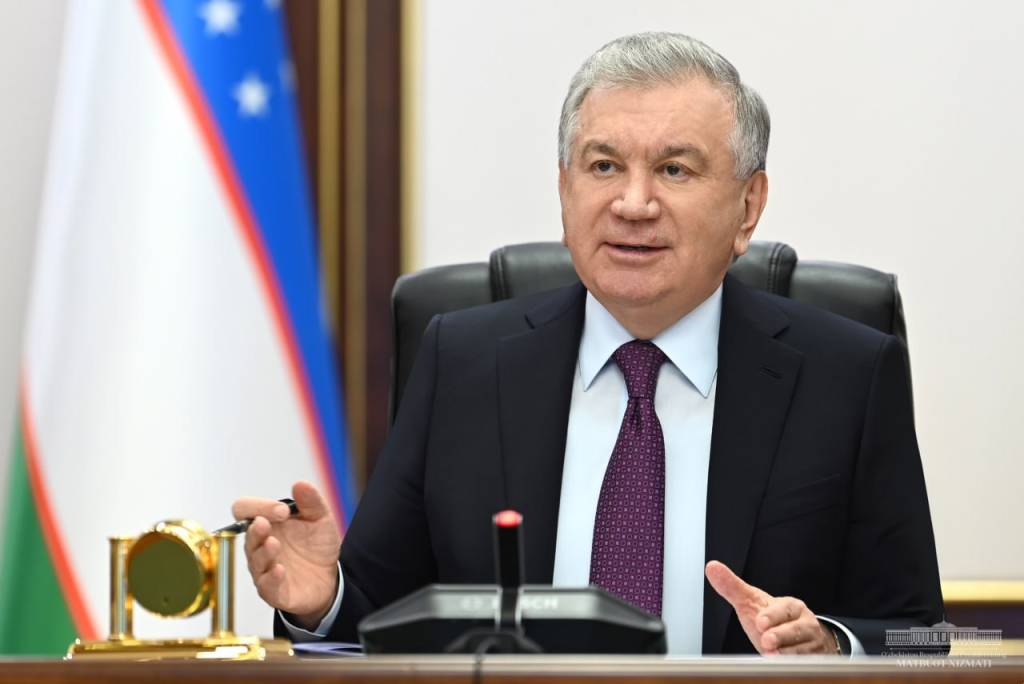Shavkat Mirziyoyev Reviews Proposals to Enhance Agricultural Water Efficiency

Tashkent, The Gulf Observer: On this day, President Shavkat Mirziyoyev engaged in a comprehensive review of proposals aimed at enhancing the efficiency of water utilization within the agricultural sector. This initiative involved a detailed presentation outlining strategies and recommendations focused on optimizing water usage practices within the agricultural framework. The President’s active engagement in familiarizing himself with these proposals underscores the government’s commitment to addressing and improving the crucial aspect of water management in agriculture, reflecting a concerted effort toward sustainable agricultural practices within the country.
Given the escalating scarcity of water resources within the nation, there’s heightened focus and priority on their judicious and meticulous utilization. Notably, significant strides have been made in recent years toward this objective. A total of 472 thousand hectares have transitioned to drip irrigation, while an additional 48 thousand hectares adopted sprinkler irrigation methods. Moreover, water-conserving technologies have been successfully integrated into farming practices, encompassing an area of 97 thousand hectares. Further enhancing efficiency, laser leveling initiatives have been implemented across 649 thousand hectares of land. These concerted efforts signify a deliberate push toward sustainable water management practices, aiming to mitigate the impact of water scarcity while optimizing agricultural productivity within the country.
As a result of these measures, 2 billion cubic meters of water were saved in 2023 alone. This is equal to the annual water consumption of Bukhara region.
Specific problems hamper the expansion of the scope of this work in the areas. For example, the powers of district irrigation departments are limited to inter-farm canals. Water supply services are not fully funded. Commercial bank loans allocated for introducing saving technologies are not attractive to farmers.
In this regard, on behalf of the Head of state, proposals were developed to improve the water resources management system’s lower level and increase efficiency.
Thus, based on regional irrigation departments and specialized services, it is planned to organize state institutions “Suv yetkazib berish khizmatlari” (Water supply services). They will be provided with excavators and other equipment, reducing the cost of servicing irrigation networks by half.
It is also envisaged to carry out an inventory of all irrigation networks, assign them to their owners, and develop a single identification number.
Starting this year, payment for one cubic meter of water supplied to the field is set at 100 UZS. It was noted that the time has come to change the stereotype that has been established in the minds of many people that water is free.
In this regard, it was proposed to organize settlements with water consumers on a differentiated basis. In particular, from 2025, it is planned to apply a lower tax coefficient to farmers who have installed water meters and introduced saving technologies and to those who have not done so, on the contrary, an increasing coefficient. At the same time, fees for water supply services will be waived.
Measures to further stimulate the introduction of water-saving technologies were also discussed at the meeting.
It was noted that a preferential credit line would be opened for these purposes. In particular, loans will be issued at 14 percent for 5 years with a two-year grace period. For projects in the Republic of Karakalpakstan and Khorezm region, the rate will be 10 percent. Farmers will not be required to pledge property when receiving such loans.
At the same time, it is possible to obtain loans online. For example, Agrobank has developed the Suvkredit.uz system. It is planned to impose additional obligations on contractors, such as constructing water-saving technologies only based on a detailed design, providing at least a two-year warranty on installed systems, and providing service for at least 5 years. The system will not include contractors who do not meet these requirements.
As is known today, a subsidy of 8 million UZS is provided for every hectare on which water-saving systems are introduced. Until now, 50 percent of this amount was paid in the year the technology was installed, and the rest was paid the following year. This condition is also planned to be simplified by paying the subsidy in full in the same year the technology was installed.
The Head of State has granted approval for these proposals and issued directives to ensure their effective implementation. Emphasizing the importance of comprehensive coverage, the instructions entail the establishment of a robust system that caters to every end user, ensuring inclusivity across the board. Additionally, there’s a mandate to broaden the scope of water conservation initiatives, signaling a commitment to expanding and intensifying efforts aimed at preserving this vital resource. These instructions underscore a dedicated approach to not only implement the proposed measures but also to enhance and extend the reach of water conservation endeavors, aligning with the nation’s commitment to sustainable resource management.


